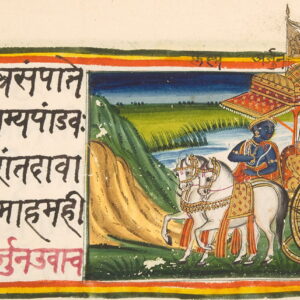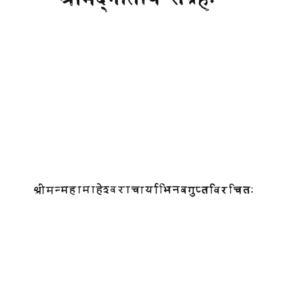Gita
The term “Gita” means “song” in Sanskrit, and in Hindu tradition, it refers to various sacred texts that are presented in the form of dialogues or discourses, often set to a poetic meter. These texts are spiritual and philosophical teachings delivered by divine or enlightened beings. Here’s an introduction to some of the most prominent Gitas:
1. Bhagavad Gita
- Context: Part of the Indian epic Mahabharata, specifically the Bhishma Parva (Book of Bhishma).
- Dialogue: Between Prince Arjuna and the god Krishna, who serves as his charioteer.
- Content: The Bhagavad Gita addresses the moral and philosophical dilemmas faced by Arjuna on the battlefield of Kurukshetra. Krishna provides Arjuna with teachings on dharma (duty/righteousness), yoga (spiritual practice), and the nature of the self.
- Key Themes: Dharma, karma, bhakti (devotion), jnana (knowledge), and the paths to spiritual liberation.
2. Ashtavakra Gita
- Context: Attributed to the sage Ashtavakra.
- Dialogue: Between Sage Ashtavakra and King Janaka.
- Content: This text focuses on Advaita Vedanta (non-dualism) philosophy, emphasizing the nature of the self as pure consciousness and the illusory nature of the world.
- Key Themes: Self-realization, detachment, and the nature of reality.
3. Uddhava Gita
- Context: Part of the Bhagavata Purana.
- Dialogue: Between Krishna and his devotee Uddhava.
- Content: Similar to the Bhagavad Gita, the Uddhava Gita covers various aspects of yoga, devotion, and philosophy. It is Krishna’s final discourse before his departure from the world.
- Key Themes: Bhakti (devotion), renunciation, and the paths to liberation.
4. Avadhuta Gita
- Context: Attributed to the sage Dattatreya.
- Content: A dialogue-free text that presents the teachings of Dattatreya on non-dualism.
- Key Themes: Pure consciousness, the illusion of individuality, and the realization of the self.
5. Ribhu Gita
- Context: Part of the Shiva Rahasya Purana.
- Dialogue: Between Sage Ribhu and his disciple Nidagha.
- Content: A comprehensive exposition on Advaita Vedanta, focusing on the nature of Brahman (the ultimate reality) and the illusory nature of the world.
- Key Themes: Non-dualism, the unity of the self with Brahman, and the practice of knowledge.
6. Ganesha Gita
- Context: Part of the Ganesha Purana.
- Dialogue: Between Lord Ganesha and King Varenya.
- Content: This Gita emphasizes devotion to Ganesha and includes teachings on various paths to spiritual realization.
- Key Themes: Devotion, yoga, and self-realization.
7. Guru Gita
- Context: Part of the Skanda Purana.
- Dialogue: Between Lord Shiva and Goddess Parvati.
- Content: The Guru Gita extols the importance of the guru (spiritual teacher) in the path to enlightenment and provides teachings on the guru-disciple relationship.
- Key Themes: Devotion to the guru, the role of the guru in spiritual awakening, and the practices to honor the guru.
8. Devi Gita
- Context: Part of the Devi-Bhagavata Purana.
- Dialogue: Between the Goddess Devi (in her form as Bhuvaneshwari) and King Himalaya.
- Content: The Devi Gita contains the teachings of the Divine Mother on the nature of reality, the self, and the practice of devotion.
- Key Themes: Shakti (divine feminine power), devotion, and the path to liberation through worship of the goddess.
Other Gitas
There are many other ‘Gitas’ in Indian literature, such as:
1.Anu gita 2. Vicakhnu gita
3. Vidura gita 4.Bhikshu gita
5.Brahmana gita 6.Bodhya gita
7.Brahma gita 8.Gopika gita
9. Hamsa gita 10. Hanumad gita
11. Harita gita 12. Iswara gita
13.Kapila gita 14. Yama gita
15. Vyadha gita 16. Vyasa gita
17.Manki gita 18.Pandava gita
19.Parasara gita 20.Pingala gita
21.Rama gita 22.Ramana gita
23.Vritra gita 24.Rudra gita
25.Sampaka gita 26.Shiva gita
27.Sriti gita 28.Surya gita
29.Suta gita 30.Swaminarayan gita
31.Uttara gita 32.Vallabh gita
33.Vasishta gita 34.Vibhishana gita
Conclusion
The various Gitas are rich sources of spiritual and philosophical wisdom, each offering unique perspectives on the nature of reality, the self, and the path to spiritual liberation. They address a wide range of themes, including devotion, knowledge, duty, and non-dualism, and continue to inspire and guide spiritual seekers around the world. Each Gita, while rooted in its specific context and tradition, shares a common goal of leading individuals toward a deeper understanding of themselves and their place in the universe.
Showing all 5 results





